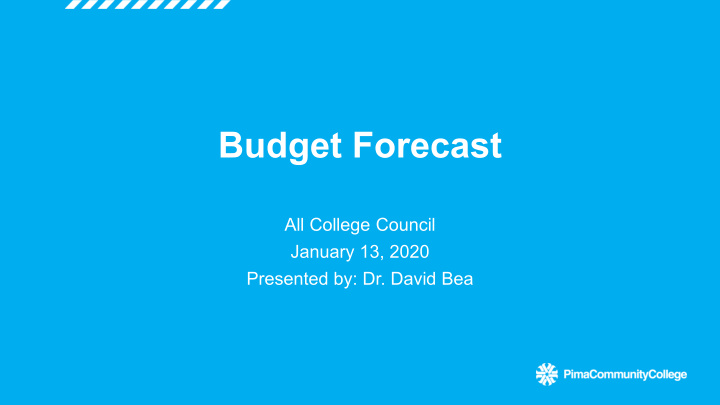



Budget Forecast All College Council January 13, 2020 Presented by: Dr. David Bea
Objectives 1. Review Budget Forecast 2. Discuss Priorities, Challenges, and Opportunities 3. Feedback from All College Council
Actual/Estimated Expenditures vs. Expenditure Limitation $140,000 $120,000 $90,355 $100,000 $80,000 $60,000 $40,000 $20,000 $- 2011 2012 2013 2014 2015 2016 2017 2018 2019 2020 2021 2022 EL ($000s) Actual ($000s)
Budgeted Salaries by Program Type, FY15-FY20 (General and Designated Funds) $60,000,000 $50,000,000 $40,000,000 $30,000,000 $20,000,000 $10,000,000 $0 2015 2016 2017 2018 2019 2020 1-Instruction 3-Academic Support 4-Student Services Inst Sppt & Plant
FY20 General Fund Revenues and Expenses FY20 General Fund Revenues by Source FY20 General Fund Expenses Share by Type Investment Debt Service Administrative Other Income Income Faculty 3% 3% 2% 2% Transfers & Reserves 12% 17% Tuition & Fees 28% Adjunct 8% Operating 17% Property Taxes 68% Staff Classified Other Compensation Fringe Benefits 23% 3% 14%
Challenges • Struggling enrollment and declining outlook • Limited potential growth in other revenues • Structural inefficiencies and continued resistance to reductions • All services at all places • Classroom inefficiencies (scheduling, course capacity) • Funding College priorities with limited EL capacity • Reallocating resources
College Priorities and Goals • Increase enrollment: recruitment, persistence, retention • Increase marketing budget • Increase institutional scholarships • Increase professional advisors and advisor:student ratio – reallocate and add resources • $0 classroom materials, integrated technology • Increase dual enrollment • Increase online enrollment programs • Decrease utility costs College-wide • Continue establishment and enhancement of COE as outlined in EMP and FMP • Compensation adjustments • Classification/compensation study • Merit pay pool • Adjunct faculty tiers • Hard-to-fill positions
Strategies and Opportunities • Increase capital leases and other financing methods for deferred maintenance • Prop 301 to fund workforce program operating expenses • Discontinue non viable program/courses and reallocate resources – Implement program and course viability studies to eliminate ineffective programs by FY22 • Reduce fringe benefit costs by shifting some cost increase to employees • Aggressive or moderate tuition increases for three years • No salary pool increases in FY21 • Fund Allied Health and Science Building through capital reserves – Proposed $10M per year • Position freezes/retirement savings
Governing Board Direction – Student-Focused Priorities • Review net savings for Open Educational Resources and strategies to reduce overall cost of attendance • Review fee structures to provide student technology • Design tuition scenarios ($0, $2, and $4) • Create a robust program to provide students with work experience • Evaluate Athletics programs
Governing Board Direction – Additional Priorities • Continue to review selling or leasing physical space • Increase marketing budget • Implement partnership programs • Seek new grant opportunities • Prioritize employee salaries and benefits
Additional Resources
Links to Additional Information • Financial Ratios • Financial and Operational Performance Indicators • Benchmarking Metrics • Expenditure Limitation Information • Understanding Property Taxes
Recommend
More recommend